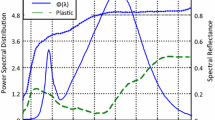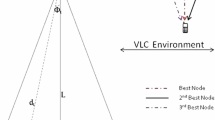Abstract
Driven by the increase in Internet of Things (IoT) devices for smart home technologies, visible light communications (VLC) using multiple light emitting diodes (LEDs) have been attracting much attention in order to cope with depleted radio frequency spectrum. This paper presents a suboptimal LED selection algorithm for distributed multiple-input multiple-output (D-MIMO) VLC systems. When total ceiling LEDs are turned on to send information while illuminating an indoor environment, the problems of low energy efficiency and mutual interference between VLC channels arise. The proposed algorithm begins by selecting the LED associated with the largest VLC channel gain and adds the LED supporting the largest level of uncorrelation with the maximum VLC channel gain in each step. Simulation results showed that the proposed scheme achieves a capacity similar to an optimal selection algorithm with reduced computational complexity. With a larger distance between the light terminals and a shorter distance between the LEDs, better channel capacity performance of the proposed scheme can be achieved.



Similar content being viewed by others
References
Sevincer A, Bhattarai A, Bilgi M, Yuksel M, Pala N (2013) LIGHTNETs: smart LIGHTing and mobile optical wireless NETworks—a survey. IEEE Commun Surv Tutor 15(4):1620–1641
Li M, Lin H-J (2015) Design and implementation of smart home control systems based on wireless sensor networks and power line communications. IEEE Trans Ind Electron 62(7):4430–4442
Kim CG, Kim KJ (2014) Implementation of a cost-effective home lighting control system on embedded Linux with OpenWrt. Pers Ubiquit Comput 18(3):535–542
Zhao S, Xu J, Trescases O (2014) Burst-mode resonant LLC converter for an LED Luminaire with integrated visible light communication for smart buildings. IEEE Trans Power Electron 29(8):4392–4402
Tsonev D, Sinanovic S, Haas H (2013) Practical MIMO capacity for indoor optical wireless communication with white LEDs. In: Proceedings of the IEEE VTC—Spring, Dresden, Germany, 1–5
Zeng L et al (2009) High data rate multiple input multiple output (MIMO) optical wireless communications using white LED lighting. IEEE J Sel Areas Commun 27(9):1654–1662
Roh W, Paulraj A (2002) Outage performance of the distributed antenna systems in a composite fading channel. In: Proceedings of the IEEE vehicular technology conference, BC, Canada, pp 1520–1524
Zhang H, Dai H (2004) On the capacity of distributed MIMO systems. In: Proceedings of conference on information sciences and systems, Princeton, pp 1–5
Petros SB, Athanasios SL, Angeliki A (2014) Exploiting spatial correlation in distributed MIMO networks. AEU-Int J Electron Commun 68:270–276
Bohagen F, Orten P, Oien G (2007) Design of optimal high-rank lineof- sight MIMO channels. IEEE Trans Wireless Commun 6(4):1420–1425
Sarris I, Nix A (2007) Design and performance assessment of highcapacity MIMO architectures in the presence of a line-of-sight component. IEEE Trans Veh Tech 56(4):2194–2202
Dambul KD, O’Brien D, Faulkner G (2011) Indoor optical wireless MIMO system with an imaging receiver. IEEE Photon Technol Lett 23(2):97–99
Fath T, Haas H (2013) Performance comparison of MIMO techniques for optical wireless communications in indoor environments. IEEE Trans Commun 61(2):733–742
Nuwanpriya A, Ho S-W, Chen CS (2015) Indoor MIMO visible light communications: novel angle diversity receivers for mobile users. IEEE J Sel Areas Commun 33(9):1780–1792
Wang TQ, Green RJ, Armstrong J (2015) MIMO optical wireless communications using ACO-OFDM and a prism-array receiver. IEEE J Sel Areas Commun 33(9):1959–1971
Chvojka P, Zvanovec S, Haigh PA, Ghassemlooy Z (2015) Channel characteristics of visible light communications within dynamic indoor environment. Lightwave Technol 33(9):1719–1725
Acknowledgements
This research was supported by the Academic Research fund of Hoseo University in 2016 (2016-0041).
Author information
Authors and Affiliations
Corresponding author
Rights and permissions
About this article
Cite this article
Kim, B. Suboptimal LED selection for distributed MIMO visible light communications. Pers Ubiquit Comput 22, 105–110 (2018). https://doi.org/10.1007/s00779-017-1080-7
Received:
Accepted:
Published:
Issue Date:
DOI: https://doi.org/10.1007/s00779-017-1080-7




